Discuss Notion Music Composition Software here.
4 posts
Page 1 of 1
|
I just converted a PDF to XML and it was a bit hit or miss. Sometimes the tuplet markings were recognized, sometimes not.
Most of the triplets are notated as a quarter note and an eighth note, the same as the first two notes of an eighth note triplet being tied. The kicker is, that some of these do have the triplet marker and play correctly, and some don't and are played straight. Fair enough, but when I select the non-tripletized note pairs, I can't convert them to triplet duration. The option doesn't come up. I have to convert the quarter note into two eighths before I can create a triplet, then tie the first two. Am I doing something wrong, or is that the way Notion is? I figure as long as the note durations add up to the proper length, you should be able to create tuplets from them. If this isn't in Notion, I nominate it for the next upgrade. If I'm mistaken, please enlighten. |
|
XML is the general abbreviation for EXtensible Markup Language . . .
THOUGHTS [NOTE: If you already know all this stuff, then let it be something that might help other forum members who might not know it . . . ] NOTION supports MusicXML and exports it and imports it . . . Lots of computer programming applications use flavors of XML, and the Bulletin Board Software for this forum uses a flavor of XML, which you can verify easily by looking at the BB code for a YouTube video . . .
The delimiting characters vary, but they tend to be left and right arrows, although they can be square brackets and whatever else a Software Engineer decides to use . . . Inside NOTION, pairs of left and right arrows ("less than" and "greater than" characters) are used . . .
These can be, and usually are, nested, which makes it like outlining in English grammar, where the rule is that these things need to be in pairs in the format shown above for tags . . .
In fact, in Computer Science terminology, XML is a grammar, and it has syntax . . . There are applications that examine a scanned PDF of sheet music and then convert it to music notation . . . Some of the forum members use this type of software, so they can provide more insights into the way it works when the music notation is intended to be input to and used in NOTION . . . I have not done this and at present have no plans to start doing it, in part because while I am conversant in music notation, I tend to prefer doing everything primarily "by ear"--although in NOTION via music notation . . . Other than thoroughly enjoying touch-typing and composing treatises on just about anything--although especially on music topics, science fiction, conspiracy theories, advanced but non-standard theories of particle physics, cooking, and a few others--my focus in this reply is explaining the software engineering perspective that XML is a general thing, hence as a rule should not be presumed to be identical and equivalent from one flavor of XML to another flavor of XML . . . I have the official transcripts of all the Beatles songs, and it's useful at times, but mostly for chords and lyrics if I cannot remember something . . . It's generally good, but it's not accurate in every respect; so I have it mostly because I like having it, not because I actually use it very often . . . If you look behind the scenes, for example, the text you see in this reply is a flavor of XML and most likely involves "HTTP", "CSS", and a few other primarily web-based languages . . . I am connecting a few dots arbitrarily, but among other things I am a Computer Scientist and Software Engineer, which maps to being able to connect a few dots in one way or another with some level of accuracy . . . I did a bit of research on the matter, and NOTION does not do the conversion from (a) PDF of music notation to (b) MusicXML . . . This is done by another application like "ScanScore", and it's not completely accurate in every instance . . . [NOTE: There are other such applications, but this is the first one I found. It looks good, and there is support for manually correcting conversion errors, which is important, as explained later . . . ] ScanScore Scanning is not always so perfect, and in some instances there are no one-to-one mappings, where the best example is MIDI and music notation . . . MIDI is digital, but music notation is analog in the way I use the terms "digital" and "analog" . . . There is no one-to-one mapping of MIDI to music notation and vice-versa, so converting from one to the other is as much an art as a science . . . Consider my favorite Rammstein song, "Du Hast" . . . Best wishes on transcribing the drum and rhythm guitar parts . . . Why? They are syncopated, and it's virtually impossible--or at least very difficult--to notate highly syncopated instruments with music notation . . . Based on what you wrote in your post and the focus on tuplets, I think you understand this very well . . . I play electric guitar, and while I can play the rhythmic chord patterns to "Du Hast", it would be very difficult for me to transcribe them using music notation . . . My perspective on the analog aspect of music notation is that it's mostly what I call "binary" in the sense that note durations mostly are multiples of two {whole, half, quarter, eighth, sixteenth, and so forth} . . . If you need an odd duration, then this is where tuplets become vital; but even then there are things musicians can play easily but are difficult to notate, no matter how much you resort to using tuplets and other such devices . . . Making it all the more absurd in some respects, NOTION converts the music notion to MIDI; and when you are using VSTi virtual instruments, NOTION sends MIDI to the respective VSTi virtual instrument engines . . . No matter how you are converting sheet music in a PDF to XML, it's probably not going to be perfectly accurate, which is what intrigues me about ScanScore, since ScanScore has the ability for you to make manual corrections when there are conversion errors . . . For reference, one of my Software Engineering specialties is designing and programming Parsers and Syntax Analyzers, which I do the way it was done in what one might call the "Dinosaur Days of Mainframe Computing" when mainframe computers were about the size of a house and had thousands of vacuum-tubes . . . I do this in low-level C, and it's all hand coded, where nothing happens unless I allow it, which I suppose makes me a bit of software dictator, but so what . . . In some respects, it takes long, but my parsers and syntax analyzers are highly accurate . . . For reference an Apple Watch is more powerful than a 1950s mainframe computer and is a vastly tiny physical package . . . Technically, a big part of the overall problem is that Software Engineers are not always so musical, although as a rule musicians tend to be excellent Software Engineers . . . Specifically, when there are no absolute one-to-one mappings, how well one handles the "art" aspect depends strongly upon how well one understands the nuances of the "art" and how well one can devise strategies for determining the "best and most accurate fit" when there is no obviously absolute rule . . . Yet, I suggest that there are absolute rules, but only when one allows more than the obvious set of rules . . . SUMMARY The "workaround" is to print the sheet music and then to transcribe it to music notation yourself by inputting the music notation in NOTION one note and articulation, dynamic, and playing style at a time . . . Using a conversion application like ScanScore can make it much easier--provided the PDF is scanned accurately and the sheet music is accurate . . . One more example is fitting . . . NOTION has a library of scores, and one of them is "Tchaikovsky Nutcracker Act 2, No. 12c - Chinese Dance" . . . A few years ago in 2016, I used this NOTION score with the native NOTION bundled instruments but enhanced them with some VST effects plug-ins from IK Multimedia and FabFilter Software Instruments and did a new mix . . . I am licensed to use all that stuff, and after doing it, I posted the result to my YouTube channel . . . A few days later, a supercomputer in France decided that I was a Russian Symphonic Orchestra and was violating their copyrighted performance recording . . . YouTube gave me two ways to respond to the copyright violation claim: (1) agree to let the French company have whatever money was generated from YouTube views, thereby admitting that I violated their copyright OR (2) protest and defend my work The problem with (2) is that if my protest had been unsuccessful, then I could have lost my YouTube channel privileges . . . Since I did not violate anyone's copyright and am not a Russian Symphonic Orchestra, I chose to protest . . . I was successful in the protest--of course--but the way this is relevant to the topic is that it's a real-world example of what sloppy software engineering and artificial intelligence algorithms can do in what one might call the "Skynet (Terminator)" part of reality, which is very real . . . This is the protest and my detailed response, as well as YouTube's determination: 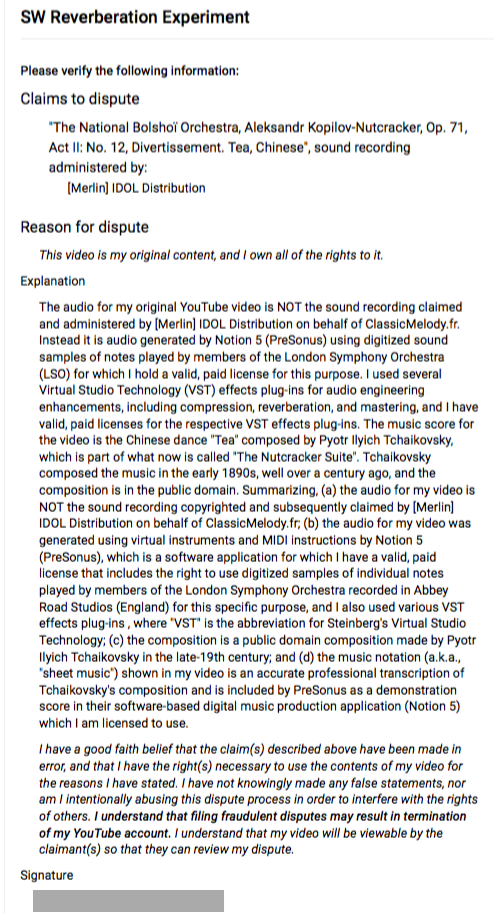 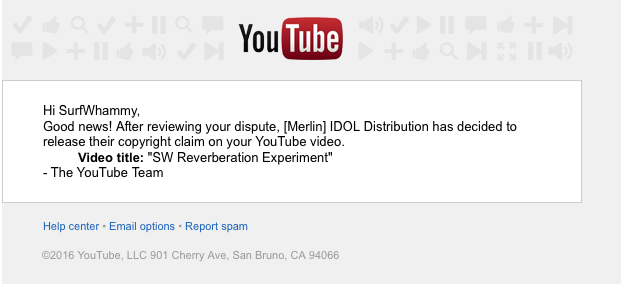 [NOTE: This is the song done in NOTION with native NOTION bundled instruments and VST effects plug-ins, mostly for reverberation. One of the flute notes sounds flat, but it's probably because I set "Concert A" to 440-Hz, the generally accepted standard reference tuning pitch, but the NOTION London Symphonic Orchestra (LSO) samples are recorded at 432-Hz reference pitch, but so what. Everything else sounds correctly tuned, so perhaps it's a "flute thing". Of course, it's possible the aforementioned Russian Symphonic Orchestra has a lead flutist who is tone-deaf . . . On the good side, I think a Skynet (Terminator) supercomputer in France deciding I am Aleksandr Kopilov conducting the National Bolshoi Orchestra is indisputable evidence that NOTION is fully capable of creating professional quality symphonic audio--noting that the National Bolshoi Orchestra recording is available on Apple iTunes, while my version made with NOTION 5, LSO sampled sound library, and assorted VST effects plug-ins is available for free on my YouTube channel . . . Lots of FUN!
Surf.Whammy's YouTube Channel
The Surf Whammys Sinkhorn's Dilemma: Every paradox has at least one non-trivial solution! |
|
Interesting replay. I assumed folks would know I meant MusicXML, but I'll be more specific from now on. I should know better.
Thanks for all the info, and yes, it appears the only solution at present is to hand-enter notes. The MusicXML file does give me a head start, completely accurate or no. My actual issue is that Notion's tuplet tool doesn't appear to have the smarts to convert a quarter and eighth note to three eighth note triplets, etc. though there appears to be an allowance in MusicXML for such a pattern. But this post was to confirm that this is the case, and that I'm not missing a trick or doing something wrong. This is actually an understandable oversight but it would be handy you were able to tuplet-ize disparate note durations that still added up to the overall duration of the desired tuplet. |
jonljacobi1 wroteMy actual issue is that Notion's tuplet tool doesn't appear to have the smarts to convert a quarter and eighth note to three eighth note triplets, etc. though there appears to be an allowance in MusicXML for such a pattern. I'm not certain this type of conversion is logical, although it might be an interesting option . . . THOUGHTS Consider the following measures:  I think the first two measures are equivalent, but one has the upper-tuplet bracket while the other has the number but not the upper-tuplet bracket . . . The third measure is an eighth-note triplet, and it is different from the first two tuplets . . . Expressed in words, a quarter note and an eighth note in a 3:2 tuplet is "kaaaaaaaa boom" where the "kaaaaaaaa" part is longer than the "boom" part, while three eighth notes in a 3:2 tuplet is "boom boom boom" . . . The quarter note and eighth note tuplet is two notes, while the three eighths, non-tied flavor is three notes . . . Played on a drumkit, the first flavor might be a syncopated long floor-tom note and a snare drum rimshot, while the second flavor might be three syncopated rimshots . . . They are not equivalent, and they are not the same . . . The first two-note tuplet is similar to the definitive drumkit, bass, and rhythm guitar kick-off to a lead guitar solo, which occurs at 3:05 in "Whole Lotta Love" (Led Zeppelin)--except it's probably two syncopated, equal-duration notes rather than one long note and one short note, although perhaps not . . . Now consider this flavor:  They are the same tuplets, where the first two are equivalent but the third is different . . . Observe that all three have the upper-positioned tuplet brackets . . . The first version uses the default bracketing option, but the second version is done by specifying bracketing, which is done with the "Show Bracket" option on the context menu (right-click with mouse on the Mac) . . . 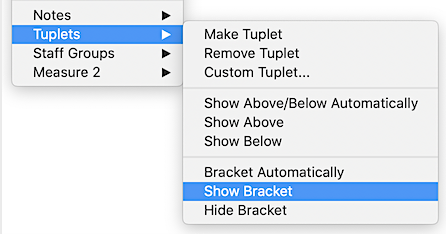 Depending on the way one defines "triplet", all three are triplets in the sense that each is "three beats played over two beats" where an eighth note gets one beat, but the important aspect is the "3" above each tuplet . . . Since the tuplet with three, non-tied eighth notes is different from the first two, doing a conversion of the first two to be like the third one at best could be an option--not something done automagically--because it would change the way the notes were--and should be--played . . . In the same way as there are references for typesetting English like the "Chicago Manual of Style", and there are various dictionaries for English with the definitive dictionary being "The Oxford Dictionary of the English Language (OED)"--which is available in a compact edition comprising two volumes each of which is approximately 16" by 10" by 3", and the set includes a magnifying glass, since the type is very tiny--there are standard references and style guides for music notation . . . [NOTE: The professional quality magnifying glass is stored in the compartment at the top of the bookcase. For reference, the large-size OED is 20 volumes, but the compact edition has the same information but in very tiny text; and there are used books available at very attractive prices where one of the key aspects is that a well-handled version in good condition from 50 years ago will be just as relevant as the 2022 edition, except it will not have definitions for "twerking", "woke", and all that nonsense. I have one of these, and I study it, where one of the FUN aspects is using it to win mostly absurd arguments about word usage, where it's a great defense for claiming something like "I am using the word the way it was used in 1222 AD by Lord Piffleton in his address to the Wattley Ladies Knitting Club in Hastings" . . . 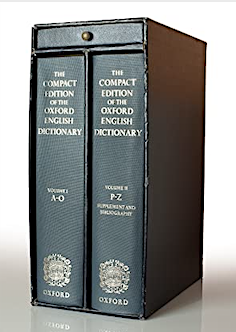 There was a interesting discussion several years ago in which one of the NOTION software engineers provided the name of the music notation reference guide and style manual used for NOTION, but at present I do not recall the name of the specific book . . . I think it might have been before PreSonus acquired NOTION; and if so, then it would be in the Notion Music Forum archive . . . Otherwise, it's in the current PreSonus NOTION Forum, so I leave this as an exercise . . . [NOTE: I did a quick search of the archived Notion Music Forum, and found a reference to one of the guides used in NOTION. The Admin at the time mentioned this book but said there were other references used by the developers . . . ] 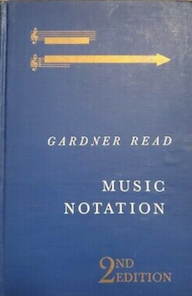 I mention this, because while it might appear that NOTION does things based on random rules for music notation, this is not the case . . . NOTION follows a precise set of rules and styles for its music notation; and this includes MIDI importing and exporting, and MusicXML importing and exporting . . . Regarding showing brackets for tuplets, hiding brackets for tuplets, as well as the positioning of such brackets when shown, this can be specified via the context menu (right click on the Mac) when a tuplet is selected (as shown above) . . . There are options for tuplets when doing MIDI recording and MIDI importing, as well, and they are specified in NOTION "Preferences". . . 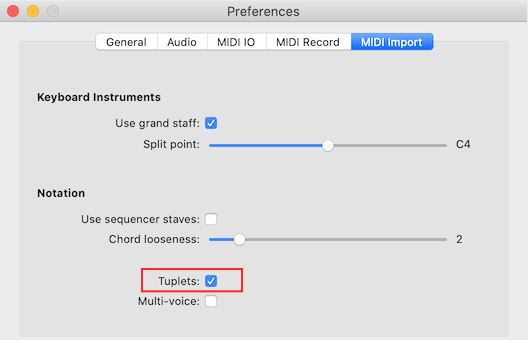 Lots of FUN! P. S. I provide this level of detail for several reasons, one of which is that it's the way I learn more information about NOTION and Studio One Professional, which work cooperatively in ReWire sessions where Studio One Professional is the ReWire host controller and NOTION is the ReWire helper device . . . The more you discover and learn about these PreSonus applications--as well as VSTi virtual instruments and VST effects plug-ins--the more you can do . . . Consider this version of a chapter in "Extreme Gravity", the science fiction radio play I am developing, and observe that it's a ReWire session . . . [NOTE: This is mixed specifically for headphone and Apple AirPods listening, since it's a stereo mix with motion and echoes designed for {far-left, top-center, and far-right) panning. Everything except my vocal work is done with VSTi virtual instruments and music notation . . . ] The top-half of the display is Studio One Professional, which is the ReWire host controller; and the bottom half of the screen is NOTION, which is the ReWire helper device . . . ReWire ensures that everything is synchronized and interacts cooperatively . . . If I want to do something in NOTION, then I click in the lower-half of the display, and I am working in NOTION where I can do everything NOTION does, including adding more VSTI virtual instruments by putting them on ReWire MIDI staves; and I can edit and modify the music notation . . . When I want to work specifically in Studio One Professional, I click on Studio One Professional in the top-half of the display; and now I am working in Studio One Professional, where for reference nearly all the VSTi virtual instruments and VST effects plug-ins are hosted in Studio One Professional . . . Everything is intuitive and natural in terms of the overall working environment . . . Studio One Professional handles the VSTi virtual instrument hosting and VST effects plug-ins, as well as the audio, mixing, and everything else a Digital Audio Workstation (DAW) application does . . . NOTION handles the music notation and my favorite virtual female soprano, Realivox Blue (RealiTone), which is hosted directly in NOTION, since she uses keyswitches and this is easier to do when Kontakt (Native Instruments) is hosted directly in NOTION on a VST stave with the generated audio sent to Studio One Professional via a ReWire channel pair . . . I use the Melodyne Editor (Celemony) for pitch correction and custom echoes and harmonies, and since Studio One Professional works cooperatively with Celemony, I do this custom work directly in Studio One Professional, as well . . . Both applications (Studio One Professional and NOTION) are running simultaneously in the ReWire session, and if I want to record voices and real instruments, I can do this in Studio One Professional . . . To the best of my knowledge, PreSonus is the only company that has these products with such complete interaction . . . MOTU, Reason Studios, and Steinberg do not do this level of interacting, at least with ReWire MIDI; and none of them have the sophisticated music notation provided by NOTION for ReWire sessions . . . There are ways to do something similar, but they are not interactive at the level of a ReWire session, which makes it quite cumbersome . . . This is the easiest and most logical and natural way to do this type of composing, arranging, instrumenting, recording, producing, audio engineering, mixing, and mastering, which is fabulous . . . Fabulous! P. P. S. Now that Studio One Professional 6 is released, ReWire is no longer supported by Studio One, although it is supported by Studio One Professional 5.5 and NOTION 6.8 . . . Instead of doing ReWire sessions with Studio One Professional 5.5 as the ReWire host controller and NOTION as the ReWire helper device, everything is done within Studio One Professional 6--no ReWire and no NOTION required . . . The work that was done with NOTION now is done in the music notation Edit window of Studio One Professional 6, and no ReWire session is required . . . NOTION also is not required, but it can be used to Send music notation to Studio One Professional 6, as well as to receive music notation from Studio One Professional 6, although this is done offline, not in a ReWire session, since ReWire no longer is supported . . . PreSonus has packaged NOTION inside Studio One Professional 6, and it's very nice . . . This is the strategy I recommend now . . .
Surf.Whammy's YouTube Channel
The Surf Whammys Sinkhorn's Dilemma: Every paradox has at least one non-trivial solution! |
4 posts
Page 1 of 1
Who is online
Users browsing this forum: No registered users and 14 guests
